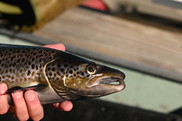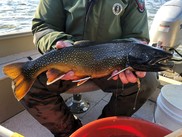|
There are 56 species of freshwater fish in Maine... You've likely heard of many of them! Brook trout, landlocked salmon, lake trout (togue), brown trout, largemouth bass, smallmouth bass, and yellow perch to name a few. You can learn more about these species, what they eat, habitat, identification, and fishing tips on our website.?
Over time, fish identification often comes easy to anglers and most of the time, there is a clear difference. There are a few species that, on occasion, can be tough to quickly identify.?If you just aren?t sure, it?s always safe to release the fish.?
Read our blogs to improve your fish identification skills:
?

Brown trout or landlocked salmon?
If you are questioning your catch on whether you are holding a landlocked salmon or brown trout, you can take a look at the roof of the mouth for one clue. A double row of distinct vomerine teeth in a zig-zag pattern means it?s a brown trout. Unfortunately, a lack of distinct vomerine teeth doesn?t always mean that it?s not a brown trout.? Although salmon have smaller less developed vomerine teeth that can be prone to loss, brown trout can also lose teeth especially if they get to the age of five or older. For a correct ID, consider the species present in the water you are fishing, take a look at the caudal (tail) and adipose fins, and the alignment of the upper jaw with the eye.?
|

Brook trout or splake?
Hint: the lack of blue halos does NOT automatically mean your catch is a splake.?In many cases, splake can have blue halos around the reddish spots but the halos may be very light compared to a brook trout, of course some brook trout have light halos and, in many cases, just a few of them. Start with which species are present in the water, then look at the caudal fin (tail) and vermiculation. Splake have a slightly "forked" tail, while brook trout are known for their square tails. Other common traits of splake include spots on the gill plate, a slightly elongated head, and a ?rust? colored stomach.
|
|
